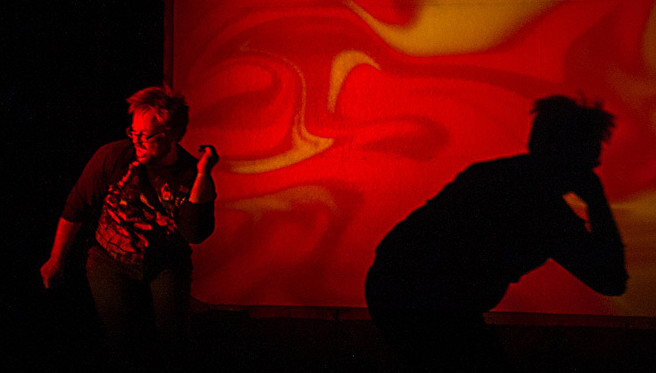TBA: Itai Erdal/Chop Theatre

Image: Tomas Valladares
As I wrote yesterday in my mid-fest recap, the prevailing focus of this year’s fest has been heady contemporary dance, which has grown rather exhausting in its preoccupation with the artist’s experience over the audience’s. By Monday, I was yearning for something that didn’t cloak itself in intentional obfuscation, something that wasn’t waging war on narrative, something that, god forbid, had a clear emotional impact. (I missed Lola Arias, which sounds like it might’ve done the job.)
Itai Erdal’s How to Disappear Completely was the perfect antidote, and, in my opinion, the best discovery of TBA:13.
Itai Erdal: How to Disappear Completely
Imago Theatre
Fri–Sat, Sept 20–21 at 6:30
Born in Jerusalem (and now living in Vancouver, BC), Erdal comes from a long line of wandering Jews. Riding the wave of documentary theater rolling over Canada, his performance incorporates storytelling and documentary footage he shot to tell the heart-breaking story of his mother’s death from cancer. And he is a masterful storyteller—charming, funny, self-deprecating, and courageously honest (he makes Mike Daisey sound like a smarmy snake oil salesman). But what elevates the show from a very good This American Life story is his profession. He is a theatrical lighting designer, and he interweaves his craft into the story to incredible comic and emotional effect.
Most of us only notice theatrical lighting when it’s really gorgeous or horrendously awful. Using a lighting board on stage like a game controller, Erdal lovingly transforms the lights into a cast of characters, revealing how, just as a movie or radio show uses music to impact mood, stage lights are fundamental to the way we experience a show. He seamlessly blends explanations of what he’s doing with the lights, such as framing himself in a square of light to emphasize that something really important is about to happen, with the plot—in this case, the moment he got the call that his mother had cancer. Or he uses an explanation of how he would use lighting to create a sense of character to describe the personalities of his family members.
You might think that peeling away the lighting curtain would lessen its impact, but paradoxically, Erdal only makes it stronger, transparently shaping our mood, but shaping it nonetheless.
The show’s pacing is impeccable. Erdal balances humor, beauty, and tragedy with the expertise of a tightrope walker. And some of the questions it touches on, such as death with dignity, are poignantly universal while also being courageously personal (to create and then perform night after night a show about your mother's death!). But ultimately, How to Disappear Completely is a profound letter of love to a mother, both wise and humorous, who we all come to cherish—and mourn—by the end.
If you see one show this weekend, make this it. And bring your mother.
